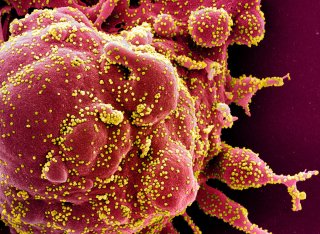Study: Coronavirus Deemed Most Contagious in First 5 Days After Symptoms Appear
Does this change our thinking when it comes to COVID-19?
The coronavirus has been found to be most contagious in the first five days after symptoms become apparent, according to a new study led by researchers at the University of St. Andrews in Scotland.
The research, published in The Lancet Microbe, discovered that although SARS-CoV-2 genetic material may still be detected in respiratory or stool samples for several weeks, no live virus that can cause an infection was seen in any type of sample collected beyond nine days of symptoms starting.
The authors of the study said the findings only further highlight the importance of early case identification and quarantining after infection.
“This is the first systematic review and meta-analysis that has comprehensively examined and compared viral load and shedding for these three human coronaviruses. It provides a clear explanation for why SARS-CoV-2 spreads more efficiently than SARS-CoV and MERS-CoV and is so much more difficult to contain,” the study’s lead author Dr. Muge Cevik said in a news release.
“Our findings are in line with contact tracing studies which suggest the majority of viral transmission events occur very early, and especially within the first five days after symptom onset, indicating the importance of self-isolation immediately after symptoms start. We also need to raise public awareness about the range of symptoms linked with the disease, including mild symptoms that may occur earlier on in the course of the infection than those that are more prominent like cough or fever.”
The researchers tapped into data from ninety-eight studies on nearly eight thousand patients infected with coronaviruses that cause coronavirus (SARS-CoV-2), severe acute respiratory syndrome (SARS-CoV-1), or Middle East respiratory syndrome (MERS-CoV). Seventy-nine, or 81 percent, of the studies involved patients who tested positive for coronavirus.
The duration of viral RNA shedding was, on average, seventeen days in the upper respiratory tract, 14.6 days in the lower respiratory tract, 17.2 in stool, and 16.6 in serum. The longest shedding times were eighty-three days in the upper respiratory tract, fifty-nine in the lower respiratory tract, thirty-five in stool, and sixty in serum.
The viral load of SARS-CoV-2 was seen to peak in the upper respiratory tract, which is believed to be the primary source of transmission, in the first five days after exhibiting symptoms. SARS-CoV-1 peaked at ten to fourteen days, while MERS-CoV peaked at seven to ten days.
Only twelve studies reported on asymptomatic individuals infected with SARS-CoV-2, and of those, six examined how quickly people were able to clear the viral material out of their bodies.
“Although viral RNA loads appear to be largely similar between those with and without symptoms, a few studies suggest that asymptomatic individuals might clear the viral material from their bodies faster,” Cevik said.
“Several studies have found that individuals with asymptomatic infection may clear the virus faster, suggesting that those without symptoms may be as infectious as those with symptoms at the beginning of infection, but may be infectious for a shorter period. However, at this stage, there are limited data available on the shedding of infectious virus in asymptomatic individuals to inform any policy change on quarantine duration in the absence of testing.”
Ethen Kim Lieser is a Minneapolis-based Science and Tech Editor who has held posts at Google, The Korea Herald, Lincoln Journal Star, AsianWeek, and Arirang TV. Follow or contact him on LinkedIn.
Image: Reuters

